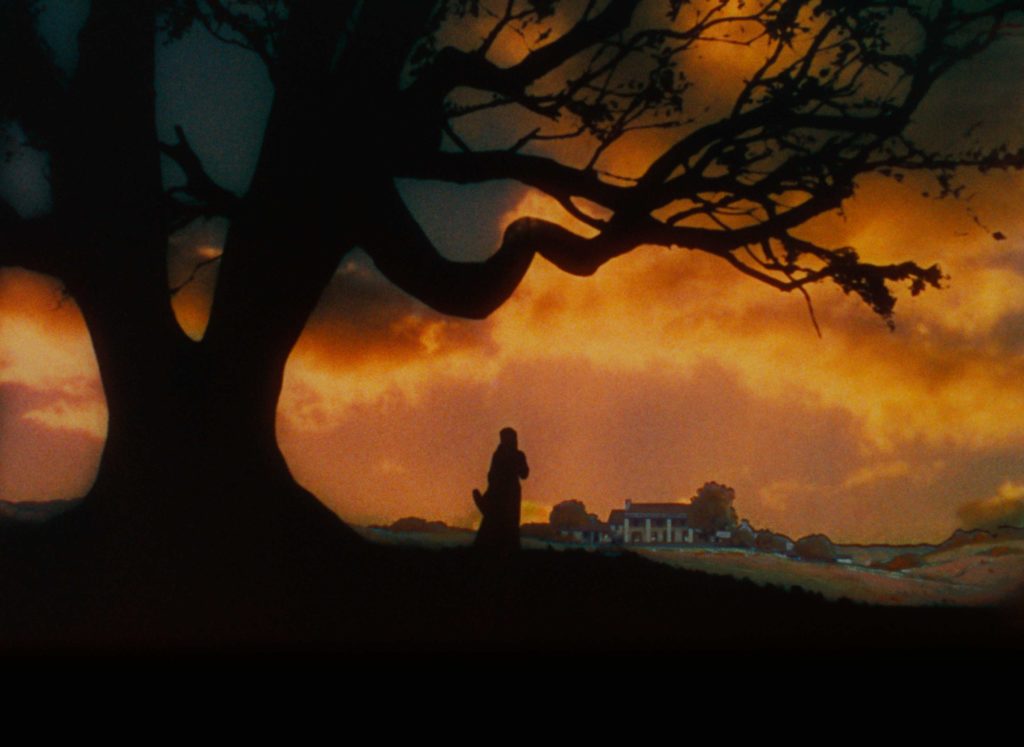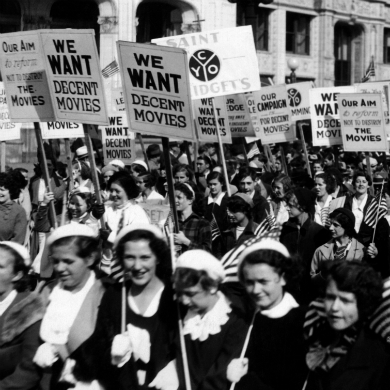Maybe it is due to some residual libertarianism (a lot of Dissident Right folks, including yours truly, came out of libertarianism) and the whole idea that corporations are not really powerful and the consumer can keep them in line with the power of their wallets, but it does seem like quite a few rightwing folks jump to threaten a boycott every time Hollywood does something egregious. And, in some ways, I agree. I will not use Netflix, as much as I like some of their shows, because of their continued push of drag queens and infanticide.
But, I am increasingly seeing my little boycott as me not wanting blood on my hands, not because I think it will change anything. In fact, I am deeply pessimistic boycotting Hollywood will work for the Right, especially in the long run. I remember these same boycotts failing time and time again during the 1980s and 1990s when the Right was much more powerful.
Looking at the history of Hollywood and I can think of one time when boycotting held Hollywood at bay for a period of time. This occurred from the mid-1930s until the early 1960s with the Legion of Decency. First, a quick history lesson. In 1930, following several high profile scandals in Hollywood, the most famous, but by no means the only one, was the “Fatty” Arbuckle scandal. Afterwards, the major American film studios agreed to the Hays Code, an industry run system that set up a series of rules they would follow in an effort to clean up their image. For the first several years of the Code’s existence it wasn’t worth the paper it was printed on and Hollywood continued to disregard it openly.
All that changed when Cardinal Dennis Joseph Dougherty, the Catholic Archbishop of Philadelphia, issued an ultimatum. Instead of issuing boycotts of individual films, he told Catholics in his archdiocese they were forbidden to see any film in a theater owned by Warner Brothers (at the time the studios owned the theaters as well), as Warner Brothers was seen as the biggest offender, thanks in large part to the gangster films like Scarface and The Public Enemy. He then told the film studios that he would take the boycott national unless they started obeying the Hays Code. Fearing a massive loss in revenue, the industry agreed, and with further backing from the Legion of Decency and several Protestant organizations with similar missions, the Hays Code was actually enforced for almost 30 years. Eventually, it broke down in the midst of the cultural revolution in the 1960s.
Now, this is not a blanket approval for the Legion. I think their hearts were in the right place. However, they were not infallible and there were several films they condemned that I either like, even though I understand why they objected to it (A Clockwork Orange for example), or I really have no idea how they got condemned (The Good, the Bad, and the Ugly). Then, there were films that I think are good for adults – at least to view from a Christian standpoint (The Exorcist). As a friend of mine pointed out, it would be all but impossible to film a Flannery O’Conner novel and it not be condemned.

With all that aside and despite boycotting being successful at one time, I do not see it working again and have laid out several reasons why I consider this to be the case.
Hollywood is Much More Powerful Now
There is a reason why Hollywood was willing to capitulate as much as it did thanks to the threat of a boycott one time. They were in debt up to their eyeballs and could not afford any loss of revenue. Another quick history lesson here. In 1927, The Jazz Singer debuted, marking the beginning of the talkies. At first, it was assumed that it was just a gimmick with no staying power. As it turned out, audiences loved talkies, forcing Hollywood to quickly convert over. By 1929, silent films were all but extinct and what was thought as just a gimmick two years earlier completely dominated the industry. Though this story is commonly talked about in terms of how many careers were destroyed- see Singin’ in the Rain– it also had another effect, the studios went millions of dollars in debt converting their theaters over to sound.
It was also in 1929 that the stock market crashed and the film industry found themselves vying for the pocket change of people wanting to forget about the Great Depression for a few hours. This is why the grandeur of 1920s Hollywood quickly disappeared in favor of smaller and cheaper films- i.e. horror films, gangster films, etc. These films could be made cheaply, quickly and turn a small, if consistent, profit margin. The grandeur of 1920s Hollywood would not return until 1939 with the release of Gone with the Wind and The Wizard of Oz. When a boycott was threatened by Cardinal Dougherty, they could take no chances and had to compromise. It is also important to remember that the film industry was still fairly new in the 1930s. In the minds of many, it was still a fad.
The Hollywood of today is a far cry from the Hollywood of the mid-1930s. The industry is a long-standing part of the culture. No one alive today can remember a time before “the movies.” Modern Hollywood did not just embark on a huge technological shift that left them deep in debt either. And, that makes them far less vulnerable and the Right is far less able to make any serious threat.
We No Longer Have Men on the Inside

That Hollywood agreed to actually obey the Hays Code, considering the financial straits they were in during the 1930s, is one thing, but what is remarkable is how long it worked – almost 30 years. The reason it worked as long as it did isn’t just because of the threat of a Legion of Decency boycott, but because, at one time, Hollywood was not as thoroughly left-wing as it is today. It would be a mistake to think Hollywood was ever a bastion for the Right. The need for the Hays Code, along with the communist presence uncovered later, proves this. But, there was also a time when there were many conservative and traditionally minded men in Hollywood able to act as a counterbalance to the left-wing presence. Indeed, almost every major position in the film industry- producer (Walt Disney), director (Howard Hawks, Frank Capra), and actor (John Wayne, Jimmy Stuart, Randolph Scott), included a prominent man of the Right. They even banded together to found their own organization to fight left-wing dominance in the film industry.
Perhaps no one was more important here than Joseph Breen, who headed the Production Code Administration from 1934-1955, with the exception of one brief break in the early 1940s. Breen made sure the Code remained in force, which is why the vast majority of Legion condemned films during his tenure were made outside the studio system, thus not under the Code. Breen’s importance can be seen in how quickly the cracks began to form in the Code not long after he retired, as Hollywood soon realized that his successor was not as tough as he was. The Code was all but dead 10 years after his retirement and was officially discarded in 1968.
Today’s Hollywood is not like that at all. The cultural revolution of the 1960s ushered in a new, far more uniformly left-wing generation of filmmakers that soon took over every aspect of the industry. That, combined with the deaths and retirements of the old guard, robbed the Right of any counterbalance it may have once had. There is a reason why today the vast majority of Republicans in Hollywood either bend over backwards to let everyone know how moderate they are (Arnold Schwarzenegger) or stay quite until they’ve retired (James Woods). The days of a John Wayne being a major player in Hollywood are gone.
They Can Outwait You
When the cultural revolution of the 1960s hit, it didn’t just change who made movies, but also movies themselves. Soon Hollywood was cranking out films that never could have been made just a few years earlier. To get an idea of how rapidly the film industry changed during the 1960s think about this – in 1965 the highest grossing film of the year was The Sound of Music and in 1967 it was The Graduate. The sort of new films, dubbed New Hollywood by historians, were the only kind of films the younger crowd in Hollywood wanted to make, they had no interest in the kinds of movies that were commonplace even two years earlier.
There was just one problem. Though the counter-culture audience that liked these films night make The Graduate a big hit in 1967 or Rosemary’s Baby a success the next year or Easy Rider a hit a year after that, they were not actually big moviegoers. At least, not enough to keep Hollywood running. The core audience in 1968 was similar to that of 1958, families with small children and older people. In chasing after the counter-culture, the film industry had managed to alienate its core audience that still wanted to see the older style films. A good example of this is The Green Berets with John Wayne, a completely unironic pep rally for the Vietnam War, similar to the sort of films made during World War II. Now, the film today is remembered as a horrible film that marked the beginning of the end of John Wayne as a major star. The film isn’t very good (it isn’t as bad as it has been made out to be either), but it wasn’t a flop. The film was actually rather popular in its day despite being savaged by critics.

There was some debate at that time if New Hollywood could actually survive or if eventually the old guard, backed by a far larger audience, would come back. But, that turned out not to be the case. Starting in 1970 and completed around 1972, that core audience more or less got used to New Hollywood and things returned to normal, at least financially. And, the film industry learned an important lesson, one they have continued to apply to this day. They can afford to impose a major change and if it backfired at first, they just wait until people eventually become accustomed to it. Upset about shows promoting transgenderism in children now? They know if they just keep pushing it you’ll eventually decide it isn’t that big of a deal. And remember, they now have the capital to wait a long time, this isn’t the 1930s.
This is especially true of the younger generation. You know how much backlash Disney has gotten for SJWing up Star Wars? A younger generation is still enjoying the films, even when they don’t understand what is being preached. The prequel trilogy is hated by original fans as well (which I am a part of), but my experience has shown those are actually fairly popular with those too young to see the original trilogy back when it was rereleased in 1997. In many cases, the prequels were the first Star Wars films they saw. The same can happen with the sequel trilogy.
Lack of Social Cohesion
Social cohesion, or lack thereof, is another reason the Right will fail in its boycott of Hollywood. Sure, they were deeply in debt when Cardinal Dougherty announced his boycott, but the film industry was willing to surrender because they knew the boycott would be followed through. It is also why it was relatively rare for films to engage in explicitly anti-Dixian themes until fairly recently. They knew that it would not play well and they would lose a huge portion of the audience. I’m not talking about something like Gone with the Wind here, let alone The Birth of a Nation, and films that came out decades before I was born.
I can remember seeing Gods and Generals in the cinema. But, looking back at that now, and to think a film like that could get a mainstream release, feels as far away and ancient as Gone with the Wind, despite being less than twenty years old. At one time, Dixie had social cohesion, and it is why there were films that portrayed us well. The threat of a film doing poorly financially because it had driven away a large section of the audience was taken seriously. Today that is all, for the most part, gone. Boycotts might only work if there is unity and we don’t have it. When the Right tries to boycott something, they know that many people, who should support the boycott, will not. Unity must come before the talk of a boycott.
It is our lack of social cohesion that has allowed the Left to get away with as much as it has. Yes, I understand it is far easier to talk about social cohesion than to actually do it. It’s hard work when working on behalf of our people can lead to a doxing. It is also only a first step. It won’t make Hollywood a new industry in debt up to their eyeballs, they will remain a billion-dollar juggernaut. It won’t give us another John Wayne or Walt Disney, at least not for another generation. Hollywood will remain. However, it can show Hollywood that we don’t need them and they can’t just push this until we no longer care. Of all the problems I listed, it is also one we can do something about. A first step, and a difficult one, but also an important one.

Conclusion
As it currently stands, the American Right must come to terms with what is really going on. The film industry is run by people who hate us, hate our history, and, especially, hate our religion. It goes beyond mere dollars, mammon is not all that is at play here. We might not be as numerous as we were in 1939 when Gone with the Wind debuted, but the audience for a pro-Dixie film is still there, they just don’t care. We must unify as a people. Then, and only then, can a boycott ever work. In the meantime, expect more trash from Hollywood.
-By Dixie Anon

O I’m a good old rebel, now that’s just what I am. For this “fair land of freedom” I do not care at all. I’m glad I fit against it, I only wish we’d won, And I don’t want no pardon for anything I done.






Boycotts take numbers and, as you point out, we don’t have numbers. Its even worse, though. Hollywood is targeting a global audience now, every big summer movie brings in a billion from China, India, Korea, etc. The numbers necessary for a meaningful boycott are astronomical.
That said, there’s a decent sized market for unpozzed movies and tv. There’s even a cost effective medium for distribution. Where there’s a will there’s a way, but we don’t seem to have the will.
I do not believe an effective Hollywood boycott (one that causes a change in Hollywood) will ever be realistic in our lifetimes or ever, unless some sort of massive human bottleneck were to occur. It is possible that we could get a successful boycott but even then the success would be limited. The reasons are the ones you gave plus the global market as stated by Rogeru. I see two alternatives that could be feasible.
1) start making our own movies. It doesn’t hurt Hollywood, but it helps us and our people. With willing and able people it could be done on a low budget. How much money did it cost to produce Office Space or Napoleon Dynamite? With the right creativity, hard work and know how we might even be able to generate a profit.
2) simply unplug and watch less boob tube. For the sake of our families we should secede from the mainstream cable/cinema/Netflix world and put together a media corpus and whatever is legal to copy could just be shared among our network. Obviously everybody should observe the law and I’m not up on what’s legal and what’s not so I cannot advise there. Everything else would of course have to be bought and paid for. Children watch too much tv anyway. Let them play tag, hide and seek and hopscotch instead, maybe learn an instrument or two. It would not be that hard to put together a collection of more video-hours than any child should imbibe. All without commercials or homo propaganda.
Things that would go well in a pro Dixie media library include:
Sitcoms:
Andy Griffith Show
The Waltons
Hee-Haw
19 Kids and Counting
Dukes of Hazzard
Southern Sportsman
Bill Dance
Duck Dynasty
Paula Dean cooking show (for girls)
Dozens of old movies. I’m not going to try to list them all here but there’s GWTW, Smokey and Bandit, dozens of pre-pozz Westerns.
Lots of old non pozzed cartoons, including Buggs Bunny, Road Runner, He-Man, Woody Woodpecker, etc. What I’ve seen of Sponge Bob seems ok too.
Ray Stevens videos
(Select) Country music videos
Educational videos
We need to stop being so dependent on Hollywood and actually live our lives. Instead of teaching our children to be brain dead zombies glued to television or phones. Teach them to read. Old books preferably because it’s better to read books by those who built society rather than those that our destroying it.